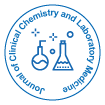
Journal of Clinical Chemistry and Laboratory Medicine
Open Access
ISSN: 2736-6588

ISSN: 2736-6588
Owen T. Griffiths*, Alan C. Spivey, Gregory Quinlan and Anthony E.G. Cass
Background: Sports anaemia is a condition associated with high levels of haemolysis after intensive exercise such as ultra-endurance rowing competitions. Studies have shown that large or continuous muscle contractions can increase the fragility of Red Blood Cells (RBCs), which can lead to intracapillary mechanical haemolysis. Toxicity from haemolysis is caused by the release of cell free Haemoglobin (cfHb), haem and iron from the lysed RBCs. Early detection of sports anaemia can prevent toxicity by facilitating earlier intervention of preventative treatments. However, there are currently no rapid, low-cost and easy-to-use sensors to detect sports anaemia.
Methods: An electrochemical sensor was developed to detect cfHb in urine which is a good biomarker for haemolysis. The sensor utilises low-cost carbon black and screen-printed electrodes. The pseudo-peroxidase activity of cfHb was used as the sensing mechanism and dried-on meta-Chloroperoxybenzioc Acid (m-CPBA) was used as the reaction oxidant. The chronoamperometric response was characterised and calibrated with Hb spiked urine before evaluating with four ultra-endurance rowers (The Enginoars) during a 37-day cross-Atlantic rowing expedition-the Talisker Whiskey Atlantic Challenge.
Results: The Limit-of-Detection (LoD) of the sensor was determined as 2.2 μM and the 5 μM recovery was 110%. The intercept was -0.28 ± 0.1 μA and the slope was -0.18 ± 0.02 μA μM-1. The mean cfHb concentration of the four rowers was 2.40, 1.56, 2.29 and 3.69 μM. The max cfHb concentration of the four rowers was 11.94, 3.77, 16.73 and 11.91 μM.
Conclusion: The study provided proof-of-principal for the sensor in ultra-endurance competitions. It showed that while there were several haemolysis spikes during the competition, cfHb levels returned to normal within 1 to 2 days.
Published Date: 2024-12-30; Received Date: 2024-11-29